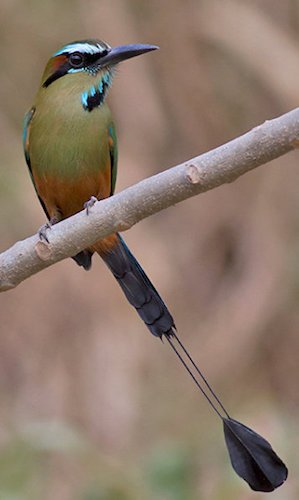Momotidae – Motmots

The Momotidae or Motmots are a family of birds in the near passerine order Coraciiformes, which also includes the kingfishers, bee-eaters and rollers. All extant motmots are restricted to woodland or forest in the Neotropics, and the largest diversity is in Middle America. They have a colourful plumage and a relatively heavy bill. All except the Tody Motmot have relatively long tails that in some species have a distinctive racket-like tip.
They eat small prey such as insects and lizards, and will also take fruit. In Costa Rica, motmots have been observed feeding on poison dart frogs.
Like most of the Coraciiformes, motmots nest in tunnels in banks, laying about four white eggs. Some species form large colonies of up to 40 paired individuals. The eggs hatch after about 20 days, and the young leave the nest after another 30 days. Both parents care for the young.
Motmots often move their tail back and forth in a wag-display that commonly draws attention to an otherwise hidden bird. Research indicates that motmots perform the wag-display when they detect predators (based on studies on Turquoise-browed Motmot) and that the display is likely to communicate that the motmot is aware of the predator and is prepared to escape. This form of interspecific pursuit-deterrent signal provides a benefit to both the motmot and the predator: the display prevents the motmot from wasting time and energy fleeing, and the predator avoids a costly pursuit that is unlikely to result in capture. There is also evidence that the male tail, which is slightly larger than the female tail, functions as a sexual signal in the Yurquoise-browed Motmot.
In several species of motmots, the barbs near the ends of the two longest (central) tail feathers are weak and fall off due to abrasion with substrates, or fall off during preening, leaving a length of bare shaft, thus creating the racket shape of the tail. It was however wrongly believed in the past that the motmot shaped its tail by plucking part of the feather web to leave the racket. This was based on inaccurate reports made by Charles William Beebe. It has since been shown that these barbs are weakly attached and fall off during routine preening. There are however also several species where the tail is ‘normal’, these being the Tody Motmot, Blue-throated Motmot, Rufous-capped Motmot, and the Amazonian populations of the Rufous and Broad-billed Motmots.
According to the IOC there are 14 extant species in this family, which are:
Tody Motmot Hylomanes momotula
Blue-throated Motmot Aspatha gularis
Russet-crowned Motmot Momotus mexicanus
Blue-capped Motmot Momotus coeruliceps
Lesson’s Motmot Momotus lessonii
Whooping Motmot Momotus subrufescens
Trinidad Motmot Momotus bahamensis
Amazonian Motmot Momotus momota
Andean Motmot Momotus aequatorialis
Rufous Motmot Baryphthengus martii
Rufous-capped Motmot Baryphthengus ruficapillus
Keel-billed Motmot Electron carinatum
Broad-billed Motmot Electron platyrhynchum
Turquoise-browed Motmot Eumomota superciliosa
-
Amazonian Motmot Momotus momota
IUCN Species Status -
Amazonian Motmot Momotus momota
Cornell Species AccountThe Amazonian Motmot is the most widespread, familiar motmot of the lowlands of South America east of the Andes. -
Amazonian Motmot Momotus momota
Species AccountSound archive and distribution map. -
Amazonian Motmot Momotus momota
Species AccountThe Amazonian motmot (Momotus momota) is a colourful near-passerine bird found in the Amazonian forests from eastern Venezuela to northeastern Argentina. This species and the blue-capped motmot, whooping motmot, Trinidad motmot, Lesson's motmot, and Andean motmot were all considered conspecific. -
Broad-billed Motmot Electron platyrhynchum
IUCN Species Status -
Broad-billed Motmot Electron platyrhynchum
Species AccountThe broad-billed motmot (Electron platyrhynchum) is a species of bird in the Momotidae family. -
Broad-billed Motmot Electron platyrhynchum
Cornell Species AccountFairly common throughout its range, Broad-billed Motmot inhabits humid forest in foothills and lowlands. -
Broad-billed Motmot Electron platyrhynchum
Species AccountSound archive and distribution map. -
Rufous Motmot Baryphthengus martii
Species AccountSound archive and distribution map. -
Rufous Motmot Baryphthengus martii
Species AccountThe rufous motmot (Baryphthengus martii) is a near-passerine bird which is a resident breeder in rain forests from northeastern Honduras south to western Ecuador, northeastern Bolivia, and southwestern Brazil. -
Rufous Motmot Baryphthengus martii
Cornell Species AccountThe Rufous Motmot is is the second largest and arguably the most spectacular of the motmots, even though it lacks the bright, iridescent patches of turquoise blue on its head that are characteristic of many other motmot species. -
Rufous-capped Motmot Baryphthengus ruficapillus
Species AccountThe rufous-capped motmot (Baryphthengus ruficapillus) is a species of bird in the Momotidae family. It is found in Argentina, Brazil, and Paraguay. -
Rufous-capped Motmot Baryphthengus ruficapillus
Cornell Species AccountThe Rufous-capped Motmot, which is endemic to the Atlantic Forest biome, was formerly usually considered to be conspecific with the Rufous Motmot (Baryphthengus martii) of western Amazonia and Central America. -
Rufous-capped Motmot Baryphthengus ruficapillus
Species AccountSound archive and distribution map. -
Turquoise-browed Motmot Eumomota superciliosa
Species AccountThe turquoise-browed motmot (Eumomota superciliosa) is a colourful, medium-sized bird of the motmot family, Momotidae. It inhabits Central America from south-east Mexico (mostly the Yucatán Peninsula), to Costa Rica, where it is common and not considered threatened. -
Turquoise-browed Motmot Eumomota superciliosa
Cornell Species AccountThe Turquoise-browed Motmot is surely one of the most flamboyantly plumaged of a remarkable family, and it is sufficiently distinctive from other motmots to be afforded its own genus. -
Turquoise-browed Motmot Eumomota superciliosa
Species AccountSound archive and distribution map.
-
Number of bird species: 14
-
Blue-crowned Motmot Momotus momota
GalleryVery good image
